Are you planning a visit to UBUD ART MARKET? Then you have to read this!
Ubud, also known as the cultural heart of Bali, is one of those places that can’t quite be described with words. It’s crazy and loud but at the same time relaxing and peaceful.
I love the feeling I get when I’m in Ubud, although I can’t quite put my finger on what that feeling is exactly.
I’ve been coming here since before Julia Roberts went on her Eat, Pray, Love journey. And although the little jungle village has become much busier since then, that magical atmosphere still remains.
Ubud Art Market is one of the most popular markets in Bali, so there are a few things you need to know to avoid getting scammed or having a bad experience. Let’s take a look at the best time to visit Ubud Art Market, what to shop and how to get the best prices.
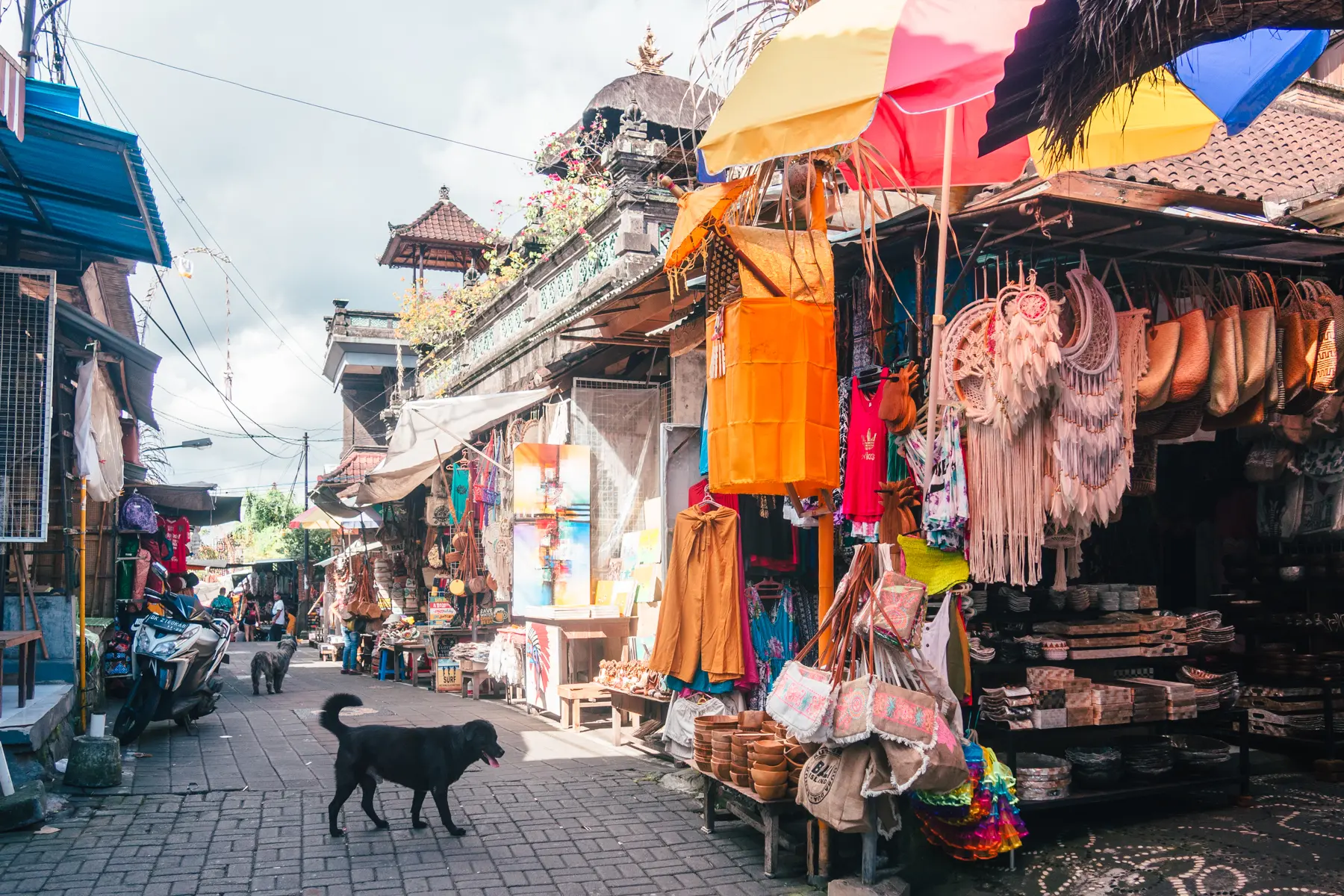

✅ DON’T FORGET TRAVEL INSURANCE!
SafetyWing is an affordable subscription travel insurance that you can purchase without knowing your itinerary in advance and even after departure.
Article overview
How to get to Ubud Art Market
Ubud Art Market, also known as Pasar Seni Ubud, is located in the heart of Ubud, a lush town in central Bali. You’ll find the entrance to the market on Jl. Raya Ubud, while the main market street is called Jl. Karna. You can also start from the opposite side at Jl. Dewisita.
Ubud is located approximately 40 kilometers northeast of Bali’s international airport, Ngurah Rai, roughly a 1 hour and 45-minute drive. From Canggu, a popular surfing destination, expect to spend around 1 hour and 15 minutes on the road.
And to reach Ubud from Uluwatu on the south coast, where you find all the best beaches in Bali, takes around 2 hours and 30 minutes.
If you’re staying in Ubud, I recommend walking to the Art Market as parking is limited. Alternatively, you can rent a scooter, or if you’re doing a day trip to Ubud I recommend hiring a private driver. Let’s take a closer look at your transport options.
Easy airport transfer to Ubud
I don’t know about you but after traveling for 16+ hours I’m not in the mood to bargain with drivers. The arrivals hall at Ngurah Rai Airport can be overwhelming with lots of private drivers, taxis and companies pushing their services on you.
🌟 Pro tip >> To make your arrival in Bali as smooth as possible, I recommend booking this driver in advance. They will wait for you with a sign in arrivals and they’ll know exactly where to take you. You also have the option to add a local sim card at checkout. Super convenient!

Rent a scooter
I highly recommend you rent a scooter to get the most out of your time in Ubud. It is one of my favorite places in Bali to drive by myself. I love zipping around on the backroads feeling the sun on my skin and the wind in my hair.
You can easily ask your accommodation to arrange a scooter for you, or motorbike as the locals call them. It usually costs around 75,000 IDR a day, but if you rent for longer periods you can bargain the price down a bit. You can also book a scooter in advance online.
Just make sure your travel insurance covers you and look out for scams run by both the police and renters. You can read more about it in my articles about common scams in Bali and things not to do in Bali.
Scooter delivery
Get a scooter delivered to your hotel or homestay. That way you don’t run the risk of being told that there are no more scooters available. It doesn’t get more convenient. All of this is included in the rental:
- Helmet for maximum 2 persons
- full tank of gas (petrol) upon delivery
- 24/7 road-side assistance
- Mobile phone holder
- First-aid kit and rain poncho (for maximum 2 people)
With a private driver
When I’m doing day trips to different parts of the island, or covering a lot of places, I often book this driver. You can, of course, drive your scooter as well, however, for longer distances I prefer to enjoy the landscape from the comfort of an air-conditioned car.
Also, parking isn’t always easy in Bali, especially not around Ubud Art Market, so that way the driver takes care of parking while you can focus on your shopping spree.
Popular Ubud Art Market tour
If you would rather have someone else plan your day, check out this popular Ubud highlights tour. It has 5 stars, with over 1300 reviews!
You will get picked up from your hotel in central Bali at 8:30 am, before heading to Celuk Art Village where you can visit a jewelry workshop and learn about silver smithing. The tour then continues to Batuan Temple, a lesser-known Hindu temple built in the classical Balinese style with elaborate carvings.
Ubud’s most popular attractions, Tegenungan Waterfall, Tegalalang Rice Terrace and the Sacred Monkey Forest are also included before the day ends at the Art Market.
🌟 Check price and availability here >> Popular best of Ubud guided tour

The best time to visit Ubud Art Market
Ubud Art Market is roughly open from 8:00 am to 6:00 pm. However, some stalls open later and keep it going into the evening.
The best time to visit Ubud Art Market is in the morning, shortly after it opens. Visiting early in the day allows you to explore the market when it is less crowded, providing a more relaxed and enjoyable shopping experience.
The Balinese also believe that the first sale in the morning blesses the rest of the day. So they are eager to get that first sale in and are often willing to reduce prices significantly.
We got to the market at 8:50 am, just as the last few vendors finished setting up their stalls and before the crowds started rolling in. Perfect timing!
If you can’t make it in the morning, get there around 4:30-5:00 pm when most tourists are heading back to their accommodation to get ready for dinner.

What to expect at Ubud Art Market
On our first morning back in Ubud, I was in the mood for a major shopping spree. Lucky for me, Ubud Art Market, which is located opposite the Royal Palace, is one of the largest markets in Bali, and even better than the hip markets in Canggu.
What started as a place for local artisans to showcase and sell their handicrafts has since turned into a haven for lovers of all things bohemian/coastal interior decor. Throw in a sea of colorful dresses, rattan bags and some cute cafés and you have arguably Bali’s best market.
I had already visited Ubud Art Market several times before, but I gotta say, they’ve stepped it up a notch since then. It definitely made me regret starting the trip out with two full suitcases bursting at the seams.
The Market consists of multiple buildings, one long street where vendors have set up shop for the day and some smaller alleys. It is ever-expanding, a mosaic of colors, textures, and sounds, with vendors calling out to the stream of visitors.
Balinese handicrafts and imported souvenirs alike will catch your eyes at every turn, from intricate jewelry to colorful sarongs. Hanging displays of hand-woven bags, delicate dream catchers, and bamboo straws offer a glimpse into the sustainable practices of local artisans.
You will be amazed by the array of homeware – sleek wooden plates and boho pillow covers beg to be touched. The market brims with a variety of clothing too; racks overflow with dresses, shirts, and the infamous backpacker elephant pants.
Ubud Art Market entrance fee
There’s no entrance fee at Ubud Art Market, only a small fee for parking of 2000-5000 IDR. However, parking is limited, so get there early, hire a driver or walk if you can.


Have you seen anything cuter? I think I have more dog photos from this trip than of anything else. Not really a surprise tho. No matter where we go I always seem to make friends with the stray dogs.
What to buy at Ubud Art Market
There’s a reason why Ubud is called the green heart of Bali. It is lush, vibrantly green and rich with cultural heritage. Traditional Balinese craftsmen, with skills passed down through generations, call these parts home.
Woodcarvers, painters, silversmiths, mask makers and other artisans can be found in Ubud and the surrounding villages. However, these days most of what you find at Ubud Art Market are imported goods.
Even if the vendors tell you it was made in Bali, it isn’t always the case. I once bought a macrame pillow case that I was told was made by the vendor’s wife, and when I took a closer look I found a made-in-China tag inside.
- Batik fabrics: Ubud Art Market is a great place to purchase batik fabrics, which are traditional Indonesian textiles featuring unique patterns and vibrant colors. These fabrics are often used as sarongs, accessories or as decorative items.
- Wood carvings: The market is known for its exquisite wood carvings, ranging from small figurines to larger sculptures and ornate furniture. I have found so many beautiful shelves and tables I would love to bring home.
- Silver jewelry: Ubud Art Market is a hub for locally made silver jewelry, including rings, necklaces, bracelets, and earrings. Silversmithing is a big deal in Ubud and you can even learn yourself. Find out more in my guide to unusual things to do in Bali.
- Paintings and prints: The market features a wide selection of everything from traditional Balinese paintings to modern prints. These vibrant and colorful artworks are typically created on various mediums such as canvas, paper and wooden figures.
- Handwoven baskets and bags: Handcrafted baskets and bags made from natural materials such as rattan and bamboo are popular items at Ubud Art Market. These skillfully woven products come in a variety of shapes and sizes, some also decorated with seashells and beads.
- Clothing: You’ll also find a selection of lightweight and comfortable beach wear, including flowy dresses, swimwear cover-ups, baggy pants and casual shirts. A lot of which is the same as you see all over Southeast Asia. In addition, many vendors offer macrame clothing like shorts, tops and dresses.
- Balinese masks: These intricately carved and painted masks are used in traditional Balinese performances and ceremonies, making them a fascinating and culturally significant item to bring home.
- Wayang Kulit (shadow puppets): You can also find traditional Wayang Kulit, or shadow puppets, which are intricately crafted from leather and used in the ancient Balinese art of shadow puppetry. The puppets depict characters from Hindu epics and local folklore.
- Organic beauty products: The market also features a selection of locally made organic beauty products, including soaps, essential oils, and skincare items. These products often incorporate natural ingredients such as coconut, aloe vera, and traditional Balinese herbs.
- Typical souvenirs: And lastly, besides all the beautiful Balinese handicrafts, homewares and clothing, you will also find the typical souvenirs you see all over the island and Southeast Asia. Keychains, bottle openers, figurines, signs, paper fans, etc.
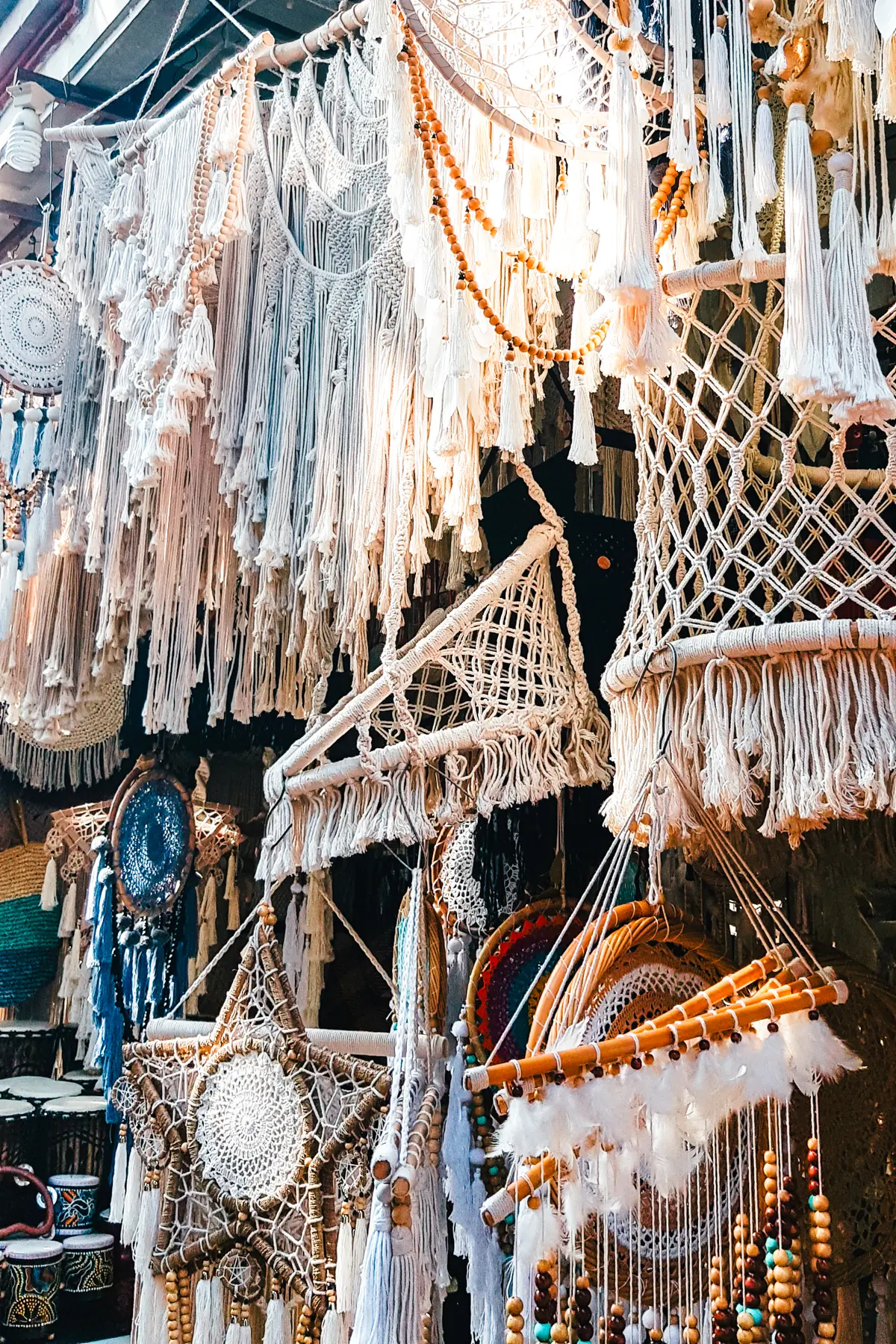
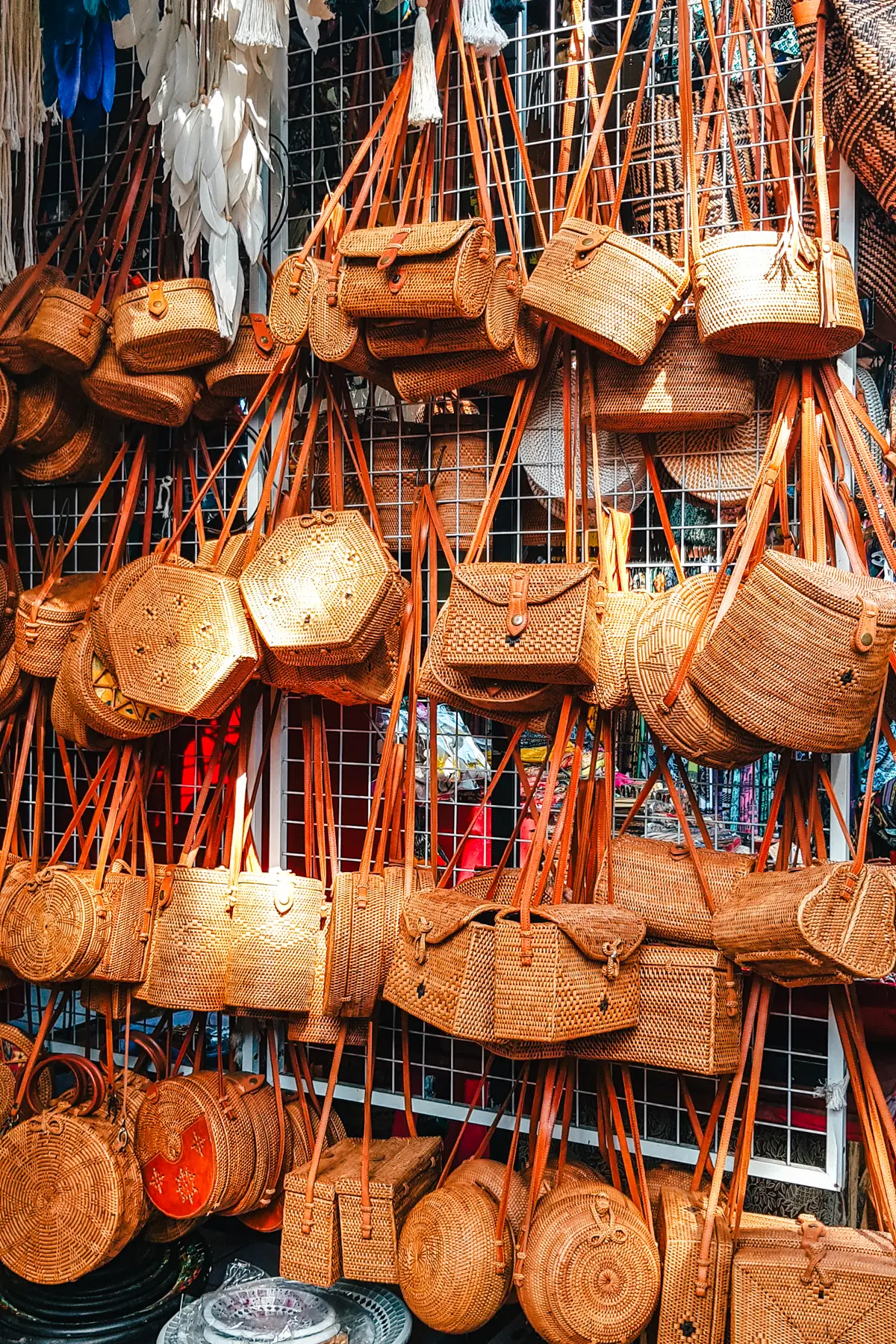
How to get the best prices
Don’t be afraid to bargain in Bali. Often vendors will even tell you to do so; “It cost 500 thousand, now you say something. Maybe 400”. And if the price is way too high, to begin with, I just say “no thank you” and walk away. Which often results in the price quickly reducing significantly.
And my second tip is to approach with a smile. I maintain a friendly demeanor, showing interest in the item but not too much. Play it cool.
Next, I decide on the maximum amount I’m willing to pay beforehand and aim to start the bargaining at about half that price. This leaves room for the vendor to counter-offer, and for me to edge up without surpassing my limit.
- Assess the situation: If a stall is crowded with buyers, the seller might be less inclined to drop the price. I look for quieter stalls where vendors seem more eager to make a sale.
- Bundle items: Purchasing multiple items from the same vendor typically prompts them to offer discounts. I’ve had more success negotiating when I show interest in several products.
- Local language: Knowing some basic Balinese or Indonesian phrases to communicate often endears me to sellers and can open the door to friendlier negotiations.
- Final price confirmation: Once we have reached an agreement, I confirm the final price with the vendor to ensure clarity and avoid any misunderstandings.
Remember, the ultimate goal isn’t to achieve the lowest possible price but to settle on a fair exchange that respects the seller and offers a good value to the buyer.
Of course, it is important to leave them with a bit of meat on the bone, however, I don’t feel that bad anymore bargaining at markets like this. They have a sea of tourists coming through every day and some of the prices are higher than what I would expect even in Norway. I’m more inclined to pay up and support vendors in more remote areas.
Don’t forget to buy an eSIM! Gone are the days when you had to get a local SIM and hope you wouldn’t get scammed.
I always use Airalo. You can easily download a data pack without having to change SIM cards. Use code NEWTOAIRALO15 to take 15% off your first order.
Is Ubud good for shopping?
Yes, Ubud is one of the best places in Bali to go shopping. You’ll find everything from local handicrafts and silver jewelry to cool indie brands, yoga wear and organic skincare.
I also stop by the Periplus bookstore every time I’m in town. I have bought some beautiful Bali coffee table books here, as well as cute notebooks and even brain puzzles. You know, to keep the upstairs going in between photoshoots and writing.

My purchases
I love to decorate my home with items I’ve picked up around the world. I have poufs from Morocco and India, crystals from Byron Bay, a rug from Afghanistan and a lamp from an antique store in Italy, just to name a few.
And Indonesia is my favorite place to shop for boho homewares. I have a huge magramé wall hanger that my sister gifted me, I have pillows made from Lombok fabric and tons of decorative pieces from Ubud and Canggu.
This time, after browsing Ubud Art Market for about two hours, I decided on the items you can see on the bed below.
My favorite is the set of 4 boxes adorned by green beads and seashells. The vendor first quoted me 800k, but when I just said no thank you and walked away, he soon dropped the price to 550k. In the end, we agreed on 350k, which is about 1/3 of what they would cost in Norway.
In addition, I got:
- 2 light and airy dresses, perfect for the humid weather.
- 1 straw bag for shopping or the beach.
- 1 pouch with white beads.
- 1 pink and red sarong (you can never have enough sarongs in Bali).
- 1 beautiful sudoku book and 1 with brain puzzles.
I ended up spending around 1.3 million IDR at Ubud Art Market, which sounds scary but is only around $80. If you’re wondering how much you should budget for your holiday in Bali, be sure to check out my 2 week Bali budget breakdown.
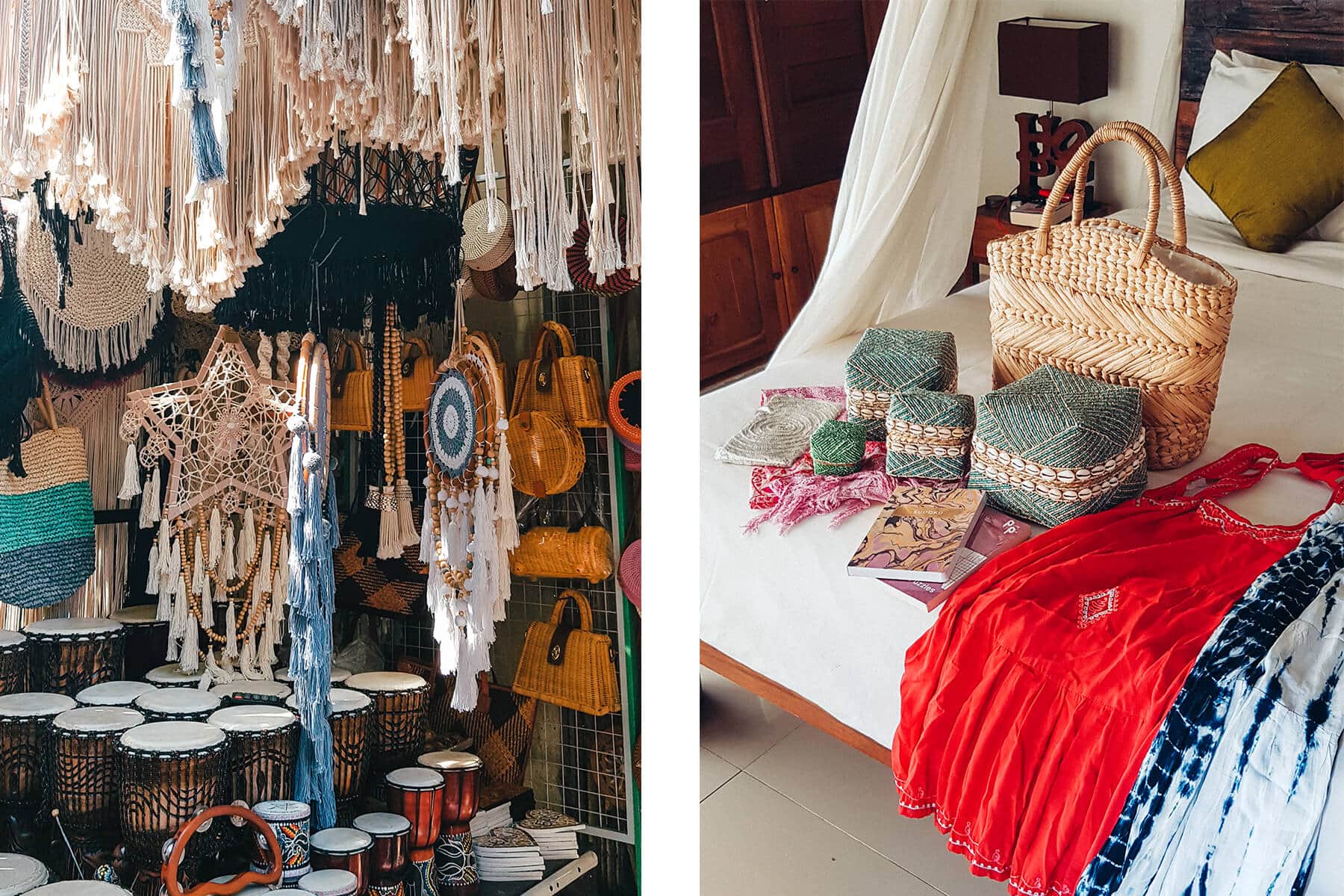
Ubud Art Market dos and don’ts
To finish off, I thought I would summarize this Ubud Art Market guide with some simple tips on what to do and don’t do to have the best possible experience.
- Start early or late: I make it a point to arrive as the stalls open or right before they close for fewer crowds and better deals.
- Bring cash: Vendors typically don’t accept cards. I always bring large and small denominations for easier transactions.
- Comfortable attire: I choose lightweight clothes and comfy shoes for ease of movement through the market It often gets very hot and humid in the middle of the market.
- Polite bargaining: Negotiate with a smile, starting at about half the asking price and working up to a fair middle ground (if the starting price isn’t ridiculously high, of course.)
- Compare prices: Check several stalls for the best prices as many vendors sell similar items. Remember that the stalls down narrow alleys and at the edge of the market typically offer better prices than those on the main road.
- Know when to walk away: If you can’t agree on a fair price, politely decline and move on, knowing there are plenty of stalls to explore.
- Watch your belongings: Be mindful of my personal items, keep your bag closed and in sight at all times to prevent pickpocketing.
- Respect the culture: Offerings are a big part of Balinese everyday life, so don’t bother the people carrying out the offerings or step on the baskets on the ground.
- Keep hydrated: Bali’s heat can be intense, so I always carry a reusable water bottle to stay hydrated throughout my market visit. Or even better, get a filtered bottle so you can fill it up anywhere.
- Talk to vendors: I engage with the sellers to learn more about the items and their origins, which often leads to a more fun shopping experience.
- Bring a reusable bag: Plastic waste is a big issue in Bali, so do your part in keeping the island clean.
🌟 LifeStraw Go Water Filter Bottle
My favorite bottle for travel, backpacking and hiking.
You can fill it up anywhere, LifeStraw filters bacteria, parasites, chemicals and microplastics.
For every LifeStraw product purchased, a child in need receives safe water for an entire school year!
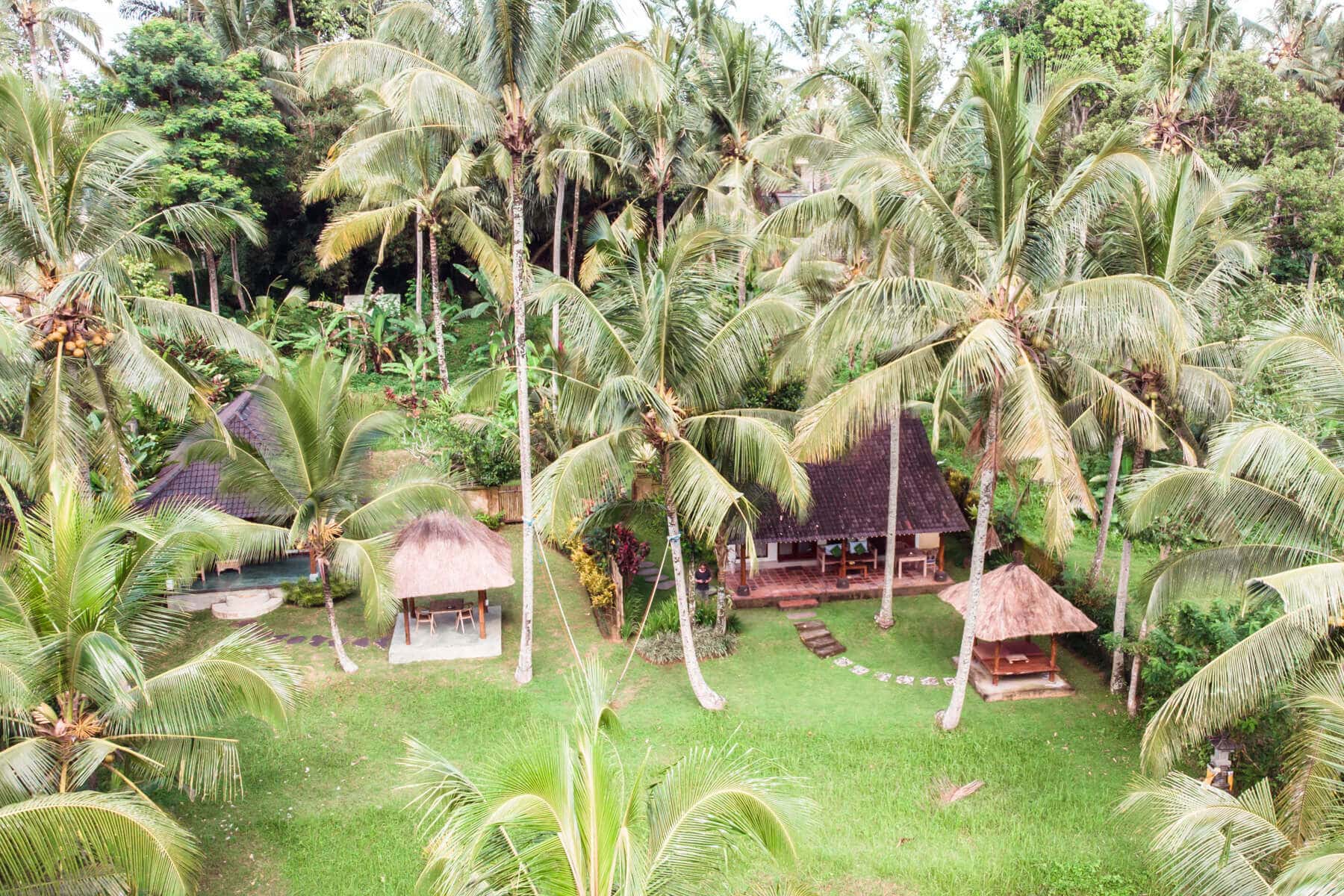
Where to stay in Ubud
Although I love Ubud, we didn’t originally plan on going back there this time. It was this little house in the rice fields on the outskirts of town that chose for us. I was looking through Booking.com for some inspiration and randomly stumbled upon the listing for Green House Ubud.
I love to discover new places that way. I see one photo of an interesting place or a cool house and then I base the trip around that.
As you can see in the photo above, there are two bungalows on the property. We rented the one the right and we couldn’t have been happier with our stay. The bungalows are light and bright, super clean and the semi-outdoor bathroom is such a nice feature.
Waking up to that view of the lush green rice fields every morning was so amazing. And there was even a swing in the garden. But the best part was, we almost didn’t see any bugs!
The two bungalows are set at the back of a traditional Balinese compound (multi-generational home). The family was very nice and even though we couldn’t quite understand each other they were always smiling and made us feel very welcome.
🌟 Click here for current price and availability >> Green House Ubud

I also love Gerebig Bungalows in Penestanan. The gardens and pool area are gorgeously green, with pathways leading through a rice field. Here you’ll experience the true Ubud feeling of peace and serenity. For about $30 you get a double room with a garden view, free breakfast and wifi. Now that’s what I call a great deal!
On the other side of town, the incredibly stunning Green Bird Villas are definitely worth checking out! A superior double will only set you back about $50 and that includes free breakfast, wifi, TV, AC ++ If you add another $20 you’ll get the deluxe room with a large bathroom and view of the awesome pool.
🌟 My most popular Bali guide >> 2-week Bali itinerary: The ultimate first-timers guide












I just visited the Ubud Art Market after reading this guide, and it made my experience so much easier and more enjoyable! The tips on bargaining and were incredibly helpful. I especially loved the local handicrafts section. Thanks for the great recommendations!
I’m so happy to hear you had a great time!! 🤗
Great guide! I’ve always wanted to visit Ubud Art Market, and your tips make it seem so accessible for first-timers. I especially appreciate the advice on bargaining. Can’t wait to visit and soak up the local art scene!
Yaay! You’re gonna love it 🙌
Loved this guide! It’s super helpful for first-timers like me. The tips on bargaining and the must-visit stalls are particularly useful. Can’t wait to explore!
Yaay! I’m happy you found it helpful 😊 Happy travels!
Wow, this guide is incredibly helpful for first-timers. Thanks for sharing such a detailed guide!
I’m happy you found it helpful 😊 I appreciate your comment!
This guide is super helpful! I’m planning my trip to Ubud soon, and are especially looking forward to exploring the art market!
I’m happy you found it helpful! Have a great time in Ubud 🤩